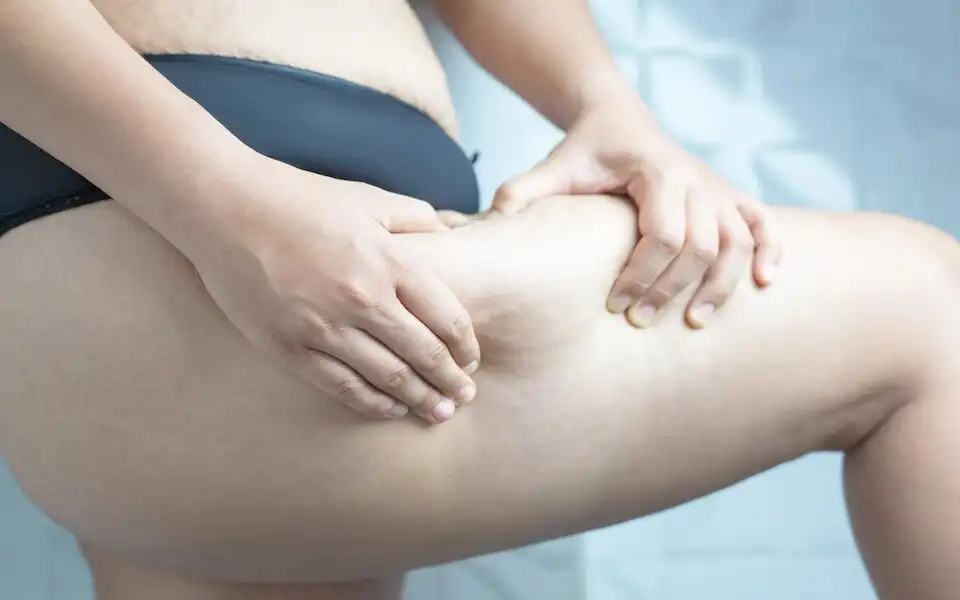For a lot of people, cellulite is a skin problem they see on their legs, hips, and buttocks. Because it has a bumpy, uneven appearance, you may have heard it called “orange peel skin” or “cottage cheese skin.” Cellulite isn’t dangerous to your health, but it can be annoying or make you feel bad about your body.
What Is Cellulite?
Cellulite is the name for the bumpy, dimpled look of skin that comes from the way fat is grouped below the skin’s surface. Body fat is not the same thing. This is what happens when fat cells push through elastic tissue under the skin. This makes the surface look bumpy or puckered because it is not level. Cellulite usually shows up in places where fat builds up, like the buttocks, legs, and sometimes the stomach.
Important to know is that a lot of people, especially women, have cellulite. Eighty to ninety per cent of adult women have some kind of cellulite, no matter what weight they are. That’s why having cellulite is normal.
The Science Behind Cellulite
To understand cellulite, it helps to know how the skin works. The epidermis is the top layer of skin; the dermis is the center layer, and the hypodermis is the bottom layer. Most of the fat cells are in the hypodermis, which is below the skin.
Under the skin, fat cells are stored in chambers or pockets that are bordered by septae, which are fibers of connective tissue. These septae are set up vertically in places where cellulite is likely to form. As fat cells get bigger, they press up against the skin. The elastic bands also pull the skin down at the same time. The skin’s surface becomes uneven because of this tug-of-war, which is what gives cellulite its dimples and bumps.
Why Does Cellulite Develop?
Cellulite is caused by a number of different things. Here are some of the important ones:
Genetic Factors
Genes play a big role in whether or not you get cellulite. You are more likely to have cellulite if your mom or grandma did. Genes affect how the skin is built, how fat is distributed, metabolism, and blood flow, all of which play a role in the growth of cellulite.
Hormonal Influences
Hormones, especially estrogen, play a big role in cellulite. Changes in hormone levels, like those that happen during puberty, pregnancy, or menopause, can make cellulite worse. Estrogen helps control blood flow and fat distribution. This is one reason why women have more wrinkles than guys.
Lifestyle Factors
Cellulite can be caused by a bad diet, not exercising enough, smoking, and not drinking enough water. When you eat too many prepared foods or sugar, fat can build up, and inflammation can happen. Muscles get weaker, and blood slows down when you don’t move around much, which may make cellulite stand out more.
Age And Skin Elasticity
Our skin loses collagen over time, making it thinner and less flexible. There is less tissue to hide fat bulges when the skin is thinner, which makes cellulite stand out more.
Other Contributing Factors
Skin and joint tissue can get stretched out quickly when you gain or lose weight, which makes cellulite stand out more. Poor circulation can cut off tissues’ oxygen intake, which can hurt the health of the skin and change how fat cells behave.
Who Is More Likely To Get Cellulite?
Cellulite can happen to anyone, but women are much more likely to have it than men because of the way their skin is built and how their fat is distributed. Cellulite is less noticeable in guys because their skin is thicker, and their connecting tissues are arranged differently.
The type of body is also important. People who have more fat in their hips and legs are more likely to notice cellulite, but very thin people can also have it. This busts the idea that only people who are overweight get cellulite. Body fat rate isn’t the only thing that matters.
Can Cellulite Be Prevented Or Reduced?
Because of genetics and hormones, it’s not always possible to completely avoid getting cellulite. But there are ways to make it look less noticeable and keep your skin healthy:
- Healthy Diet: Eating lots of fruits, veggies, lean protein, and water helps keep your skin healthy and your fat levels in check.
- Regular exercise: both cardio and power training can help tone muscles and improve blood flow, which can make the face look smoother.
- Skin Care: Moisturizers and massages may temporarily enhance circulation and skin texture.
- Medical and cosmetic treatments: Laser therapy, radiofrequency, and some creams can help get rid of cellulite, but the effects are not always the same. Before you try these, you should always talk to a professional.
The important thing is to set reasonable goals. Since cellulite is normal and common, the best thing to do is to accept your body and take care of it.
Conclusion
Cellulite is a normal disease that happens when fat presses against connective tissue under the skin, making it look bumpy. Genetics, hormones, environment, and getting older are all things that can cause it. Cellulite is more common in women, but anyone of any size or shape can get it.
Diet, exercise, and treatments can help lower it, but it’s not usually possible to get rid of it fully. Knowing about cellulite helps us see that it’s a normal part of the body and not a flaw. Focusing on healthy habits and accepting yourself is the best way to move forward instead of being down about it.
FAQs
1. Is Cellulite The Same As Fat?
Not at all. There are different kinds of fat that can cause cellulite. Normal fat is not the only kind that can do this.
2. Can Only Overweight People Get Cellulite?
Not at all. Cellulite can happen to people of all kinds, even thin people.
3. Why Do More Women Have Cellulite Than Men?
Cellulite is more common in women because of hormones like estrogen and the way their skin is built.
4. Can Exercise Get Rid Of Cellulite?
By strengthening muscles and improving circulation, exercise can make it look better, but it might not get rid of it totally.
5. Are There Medical Treatments For Cellulite?
There are solutions, like laser therapy and creams, but they don’t always work, and the effects only last a short time.




 Importance of Hydration for Your Brain, Body, and Everyday Energy
Importance of Hydration for Your Brain, Body, and Everyday Energy  Healthiest Breakfast Cereal for Children
Healthiest Breakfast Cereal for Children  Anxiety Management Techniques
Anxiety Management Techniques  What Makes Fat in Our Body?
What Makes Fat in Our Body?  Best Diet to Reduce Risk of Diabetes
Best Diet to Reduce Risk of Diabetes  Long Term Effects from Botox
Long Term Effects from Botox